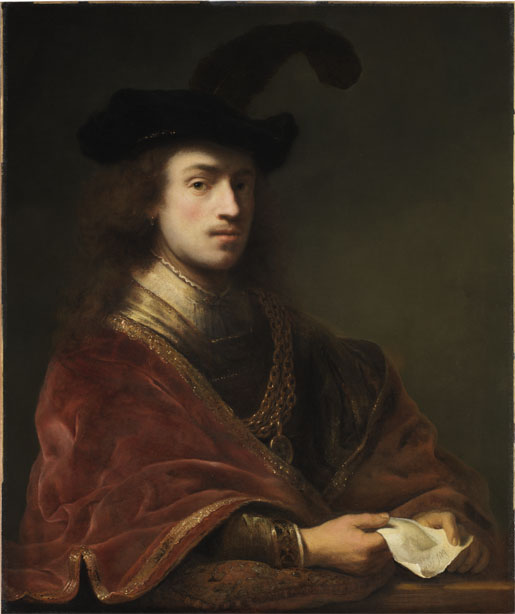Seated behind a parapet, his right arm resting with assured elegance on a richly patterned pillow, Ferdinand Bol commands the gaze of the viewer in this refined and fanciful self-portrait.1 Bol portrayed himself in the foreground of the picture plane in a three-quarter-length pose, wearing a deep red and gold-trimmed velvet cloak, thick gold chains and medallion, and a black beret topped with a long arched feather. He exudes confidence and grace, and a bit of youthful arrogance. Bol’s signature and the date of 1648 can be read on the paper he holds gingerly near the edge of the parapet.2 Against the muted brown background, strong contrasts of light and dark model his dignified form and reveal the varied textures of the fabric, particularly the sheen of the gold thread on his red cloak. His face is distinguished by a small moustache and goatee, while the brown curls of his hair reach his shoulders.
Bol executed this painting at the age of thirty-two, and though he already enjoyed a prosperous career in Amsterdam, the portrait’s heightened splendor and historicizing costume belonged to an imagined artistic and gentlemanly persona rather than to a contemporary reality.3 For this inventive mode of self-representation, Bol turned to Rembrandt van Rijn (1606–69) as his source of inspiration. Scholars have long noted how Bol modeled this image, as well as a number of his other self-portraits and tronies from the mid- to late 1640s, on Rembrandt’s 1640 Self-Portrait at the Age of 34 in the National Gallery, London (fig 1).4 Following Rembrandt’s model, Bol has here situated himself behind a balustrade, with his right arm protruding ever so slightly into the viewer’s space. His varied brushwork and use of chiaroscuro to create rich tonal contrasts also derive from Rembrandt’s prototype.5 Bol’s costume was similarly imaginative, combining, as it does, sixteenth-century elements, such as the doublet and beret, and contemporary elements such as the red cloak.6
Rembrandt’s London Self-Portrait was an assertive statement of his aspirations and capabilities as an artist.7 It evoked his status and success, as well as his Italian sources of inspiration: Raphael’s Portrait of Castiglione and Titian’s Portrait of a Man.8 Bol would have been well aware of these associations, and by basing his self-portrait on Rembrandt’s example, he positioned himself as a protégé of his master and within the framework of his great Renaissance predecessors. While it is impossible to consider Self-Portrait, Behind a Parapet without Rembrandt’s precedent, the sophistication of this image demonstrated Bol’s keen interest in self-representation and willingness to assert his own artistic identity.9
Bol both departed from and fused together Rembrandt’s models in creating this self-portrait. Large gold chains—a mark of the nobility of the painter’s profession—lie imposingly across his chest.10 Considering that Bol was never granted a gold chain, the inclusion of them here demonstrates his self-assurance about his abilities as a painter.11 In this regard, Bol’s personality may have been similar to Rembrandt’s youthful sense of self as evident in his 1629 Self-Portrait Aged 23 at the Isabella Stewart Gardner Museum (fig 2).12 This painting, created when Rembrandt was still in Leiden, shows the young artist similarly wearing a gold chain, although, like Bol, he was never given one by a wealthy or noble patron.
Bol was deeply invested in self-portraiture in the second half of the 1640s.13 In his earliest dated Self-Portrait from 1646, he depicted himself wearing a black beret, a gold-trimmed red cloak, and a thin gold chain around his neck (fig 3).14 He also extended his right gloved hand toward the viewer in a rhetorical gesture that activates the pictorial space. Bol further modified this portrait type in his Self-Portrait in Springfield, dated one year later. In this work, he portrayed himself behind a balustrade within a stone archway while pushing aside a gold-colored curtain.15 Bol appears noticeably older in the Dordrecht and Springfield works, and his facial features have changed, including a wider nose and chin and thicker moustache and goatee. These differences in physiognomy have led scholars to question the identity of the sitter in this group of self-portraits, yet they all seem to represent the artist.16 The Leiden Collection Self-Portrait stands out in this group in its blending of portraiture and fantasy, while sumptuously displaying Bol’s pictorial acumen.17 For all these reasons, this striking Self-Portrait is a fitting capstone to The Leiden Collection’s outstanding group of works by Ferdinand Bol, the largest assemblage of his paintings outside of the Hermitage.
